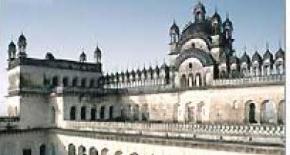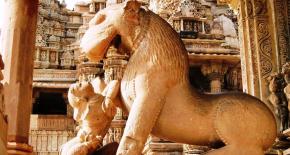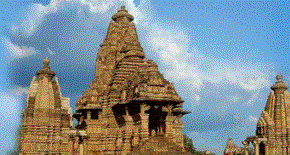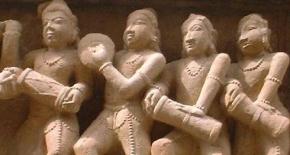
The Ancient dynasties are often covered in a veil of mystery, largely because written records are rare and, as is often the case in India, myth and legend weave their way over time into the history of their origin and their reign. And when the dynasty leaves a legacy as contradictory as the Khajuraho temples, with their mix of the religious and the sensuous, the web is woven of brighter threads, the accompanying legends more colourful. Khajuraho or "Khajur-vahika" (bearer of date palms), also known as "Khajjurpura" in ancient times, evidently derives its name from the golden date palms (khajur) that adorned its city gates and, if the different legendary versions are to be believed, it owes its existence to an enchanting maiden named Hemvati.
The Ancient dynasties are often covered in a veil of mystery, largely because written records are rare and, as is often the case in India, myth and legend weave their way over time into the history of their origin and their reign. And when the dynasty leaves a legacy as contradictory as the Khajuraho temples, with their mix of the religious and the sensuous, the web is woven of brighter threads, the accompanying legends more colourful.  Khajuraho or "Khajur-vahika" (bearer of date palms), also known as "Khajjurpura" in ancient times, evidently derives its name from the golden date palms (khajur) that adorned its city gates and, if the different legendary versions are to be believed, it owes its existence to an enchanting maiden named Hemvati. According to the account of the medieval court poet, Chandbardai, in the Mahoba-khand of his Prithviraj Raso, Hemvati was the beautiful daughter of Hemraj, the royal priest of Kashi (Varanasi). One summer night, while she was bathing in the sparkling waters of a lotus-filled pond, the Moon god was so awestruck by her beauty that he descended to earth in human form and ravished her.
Khajuraho or "Khajur-vahika" (bearer of date palms), also known as "Khajjurpura" in ancient times, evidently derives its name from the golden date palms (khajur) that adorned its city gates and, if the different legendary versions are to be believed, it owes its existence to an enchanting maiden named Hemvati. According to the account of the medieval court poet, Chandbardai, in the Mahoba-khand of his Prithviraj Raso, Hemvati was the beautiful daughter of Hemraj, the royal priest of Kashi (Varanasi). One summer night, while she was bathing in the sparkling waters of a lotus-filled pond, the Moon god was so awestruck by her beauty that he descended to earth in human form and ravished her.
The distressed Hemvati, who was unfortunately a child widow, threatened to curse the god for ruining her life and reputation. To make amends for his folly the Moon god promised that she would become the mother of a valiant son. "Take him to Khajjurpura", he is believed to have said. "He will be a great king and build numerous temples surrounded by lakes and gardens. He will also perform a yagya (religious ceremony) through which your sin will be washed away." Following his instructions, Hemvati left her home to give birth to her son in a tiny village. The child, Chandravarman, was as lustrous as his father, brave and strong. By the time he was 16 years old he could kill tigers or lions with his bare hands.
Delighted by his feats, Hemvati invoked the Moon god, who presented their son with a touchstone which could turn iron into gold, and installed him as king at Khajuraho. Chandravarman achieved a series of brilliant victories and built a mighty fortress at Kalinjar. At his mother"s request he began the building of 85 glorious temples with lakes and gardens at Khajuraho and performed the bhandya-yagya which expunged her of her guilt. A variation of the same legend introduces Hemvati as the widowed daughter of Mani Ram, the royal priest of Kalinjar. As a result of a mistake in his calculations the priest informed his king that a particular night was Puranmasi (full moon night) and not the dark night that it actually turned out to be. In her concern for her father"s reputation the beautiful Hemvati prayed to the Moon god, who was gracious enough to uphold the word of the priest but, inreturn for his favour, ravished the daughter.
The grieving father was so shame-stricken that he cursed himself and turned into a stone, which was later worshipped by the Chandelas as Maniya Dev. Hemvati gave birth to a son, the sage Chandrateya, who was later at the helm of the Chandela clan. Historically speaking, the area and aura around Khajuraho has always been renowned for its cultural achievements






About Khajuraho
In the temple architecture of India, the Khajuraho complex remains unique. One thousand years ago, under the generous and artistic patronage of the Chandela Rajput kings of Central India, 85 temples, magnificent in form and richly carved, came up on one site, near the village of Khajuraho. The amazingly short span of 100 years, from 950 AD - 1050 AD, saw the completion of all the temples, in an inspired burst of creativity. Today, of the original 85, only 22 have survived the ravages of time; these remain as a collective paean to life, to joy and to creativity; to the ultimate fusion of man with his creator. Temple town of Khajuraho is much different from any other temple city of India. It is not about religion and worshipping and deities. The temples of Khajuraho are instead famous for the eroticism etched on its walls in the form of sculptures. An amalgamation of science and art of architecture, these 10th-11th century temples have a very interesting legend behind them that connects them to the origin of Chandela dynasty. It is said that in a fit of passion and lust, the Moon God seduced and ravaged a beautiful Brahmin girls known as Hemvati, resulting in the birth of Chandravarman (the founder of the Chandela dynasty). Later, Chandravarman had a dream where his mother requested him to make a temple, which would reveal all aspects of the treasure of passion and erotic fantasy to the world. Thus he brought an artistic revolution by building the famous Khajuraho temples, in Carving On Kajuraho Templethe town, which was his capital. Some people also believe these erotic art forms to be the visual depiction of Kamasutra, art of sex or the relations between Shiva and Parvati, the divine couple. Khajuraho temples got lost into obscurity and were only discovered by chance but they quickly became India"s second most favored tourist destination after Taj Mahal. This temple complex is perhaps the largest group of medieval temples. Other than eroticism, these sculptures also depict other refined courtly accomplishments such as music and dance. Only 22 temples have survived out of the original 85 temples. It displays one of the most unique stone-carving work and was declared a World Heritage Site in 1986.
Kandariya Mahadeo , Chaunsath Yogini , Chitragupta Temple , Vishwanatha Temple , Lakshmana Temple , Matangeshwara Temple , Parsvanatha Temple , Ghantai Temple , Adinatha Temple , Duladeo Temple , Chaturbhuja Temple
Rajgarh Palace (25 km)
Panna (45 km)
Dhubela Museum (64 km)
Ajaygarh Fort (80 km)
Kalinjar Fort (100 km)
Panna Diamond Mines (56 km)
Panna National Park(40 km)
Bandhavgarh National Park (237 km)